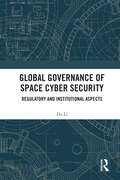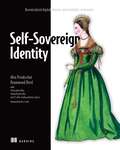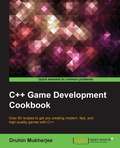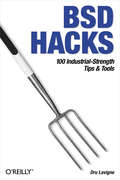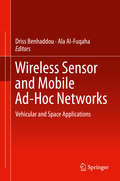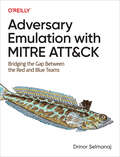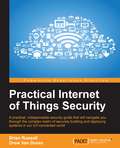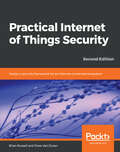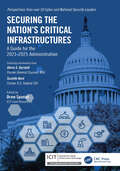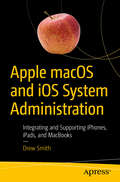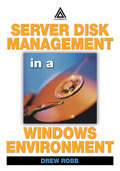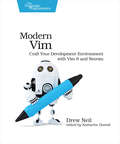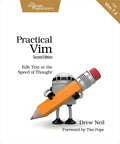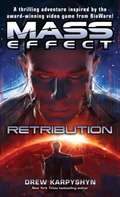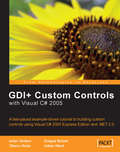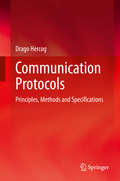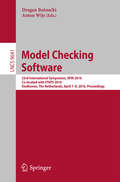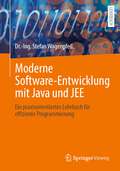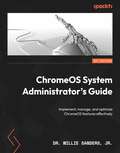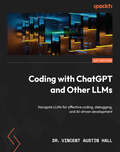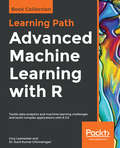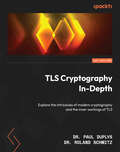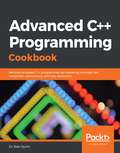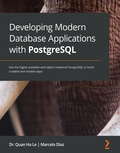- Table View
- List View
Global Governance of Space Cyber Security: Regulatory and Institutional Aspects
by Du LiThe book explores the regulatory and institutional aspects of global governance of space cybersecurity.Focusing on the regulatory aspects, this book argues that the current international law cannot handle the threats posed by malicious cyber and space activities, as regulatory gaps exist owing to terminological ambiguities and legal loopholes. A law-making process in the space field is proposed with a focus on developing soft law instruments through multistakeholder platforms. To enhance the implementation and enforcement of laws concerning space cybersecurity, it is crucial to emphasise the roles of international organisations and industries. Furthermore, empowering existing international institutions with supervisory powers and promoting national legislation and domestic judicial systems are feasible approaches to enhance compliance with the law.The book will attract international law scholars, especially those studying space law and cyber law.
Self-Sovereign Identity: Decentralized Digital Identity And Verifiable Credentials
by Alex Preukschat Drummond ReedIn Self-Sovereign Identity: Decentralized digital identity and verifiable credentials, you&’ll learn how SSI empowers us to receive digitally-signed credentials, store them in private wallets, and securely prove our online identities.Summary In a world of changing privacy regulations, identity theft, and online anonymity, identity is a precious and complex concept. Self-Sovereign Identity (SSI) is a set of technologies that move control of digital identity from third party &“identity providers&” directly to individuals, and it promises to be one of the most important trends for the coming decades. Now in Self-Sovereign Identity, privacy and personal data experts Drummond Reed and Alex Preukschat lay out a roadmap for a future of personal sovereignty powered by the Blockchain and cryptography. Cutting through the technical jargon with dozens of practical use cases from experts across all major industries, it presents a clear and compelling argument for why SSI is a paradigm shift, and shows how you can be ready to be prepared for it. About the technology Trust on the internet is at an all-time low. Large corporations and institutions control our personal data because we&’ve never had a simple, safe, strong way to prove who we are online. Self-sovereign identity (SSI) changes all that. About the book In Self-Sovereign Identity: Decentralized digital identity and verifiable credentials, you&’ll learn how SSI empowers us to receive digitally-signed credentials, store them in private wallets, and securely prove our online identities. It combines a clear, jargon-free introduction to this blockchain-inspired paradigm shift with interesting essays written by its leading practitioners. Whether for property transfer, ebanking, frictionless travel, or personalized services, the SSI model for digital trust will reshape our collective future. What's inside The architecture of SSI software and services The technical, legal, and governance concepts behind SSI How SSI affects global business industry-by-industry Emerging standards for SSI About the reader For technology and business readers. No prior SSI, cryptography, or blockchain experience required. About the authors Drummond Reed is the Chief Trust Officer at Evernym, a technology leader in SSI. Alex Preukschat is the co-founder of SSIMeetup.org and AlianzaBlockchain.org. Table of Contents PART 1: AN INTRODUCTION TO SSI 1 Why the internet is missing an identity layer—and why SSI can finally provide one 2 The basic building blocks of SSI 3 Example scenarios showing how SSI works 4 SSI Scorecard: Major features and benefits of SSI PART 2: SSI TECHNOLOGY 5 SSI architecture: The big picture 6 Basic cryptography techniques for SSI 7 Verifiable credentials 8 Decentralized identifiers 9 Digital wallets and digital agents 10 Decentralized key management 11 SSI governance frameworks PART 3: DECENTRALIZATION AS A MODEL FOR LIFE 12 How open source software helps you control your self-sovereign identity 13 Cypherpunks: The origin of decentralization 14 Decentralized identity for a peaceful society 15 Belief systems as drivers for technology choices in decentralization 16 The origins of the SSI community 17 Identity is money PART 4: HOW SSI WILL CHANGE YOUR BUSINESS 18 Explaining the value of SSI to business 19 The Internet of Things opportunity 20 Animal care and guardianship just became crystal clear 21 Open democracy, voting, and SSI 22 Healthcare supply chain powered by SSI 23 Canada: Enabling self-sovereign identity 24 From eIDAS to SSI in the European Union
C++ Game Development Cookbook
by Druhin MukherjeeThis book is ideal for aspiring game developers who are proficient in C++ programming and are interested in developing games with C++. Some basic knowledge of game programming will be useful but is not necessary.
BSD Hacks: 100 Industrial Tip & Tools
by Dru LavigneIn the world of Unix operating systems, the various BSDs come with a long heritage of high-quality software and well-designed solutions, making them a favorite OS of a wide range of users. Among budget-minded users who adopted BSD early on to developers of some of today's largest Internet sites, the popularity of BSD systems continues to grow. If you use the BSD operating system, then you know that the secret of its success is not just in its price tag: practical, reliable, extraordinarily stable and flexible, BSD also offers plenty of fertile ground for creative, time-saving tweaks and tricks, and yes, even the chance to have some fun."Fun?" you ask. Perhaps "fun" wasn't covered in the manual that taught you to install BSD and administer it effectively. But BSD Hacks, the latest in O'Reilly's popular Hacks series, offers a unique set of practical tips, tricks, tools--and even fun--for administrators and power users of BSD systems.BSD Hacks takes a creative approach to saving time and getting more done, with fewer resources. You'll take advantage of the tools and concepts that make the world's top Unix users more productive. Rather than spending hours with a dry technical document learning what switches go with a command, you'll learn concrete, practical uses for that command.The book begins with hacks to customize the user environment. You'll learn how to be more productive in the command line, timesaving tips for setting user-defaults, how to automate long commands, and save long sessions for later review. Other hacks in the book are grouped in the following areas:Customizing the User EnvironmentDealing with Files and FilesystemsThe Boot and Login EnvironmentsBacking UpNetworking HacksSecuring the SystemGoing Beyond the BasicsKeeping Up-to-DateGrokking BSDIf you want more than your average BSD user--you want to explore and experiment, unearth shortcuts, create useful tools, and come up with fun things to try on your own--BSD Hacks is a must-have. This book will turn regular users into power users and system administrators into super system administrators.
Workload Modeling for Computer Systems Performance Evaluation
by Dror G. FeitelsonReliable performance evaluations require the use of representative workloads. This is no easy task since modern computer systems and their workloads are complex, with many interrelated attributes and complicated structures. Experts often use sophisticated mathematics to analyze and describe workload models, making these models difficult for practitioners to grasp. This book aims to close this gap by emphasizing the intuition and the reasoning behind the definitions and derivations related to the workload models. It provides numerous examples from real production systems, with hundreds of graphs. Using this book, readers will be able to analyze collected workload data and clean it if necessary, derive statistical models that include skewed marginal distributions and correlations, and consider the need for generative models and feedback from the system. The descriptive statistics techniques covered are also useful for other domains.
Wireless Sensor and Mobile Ad-Hoc Networks
by Driss Benhaddou Ala Al-FuqahaWireless sensor Networks: Vehicle and Space Applications describes the practical perspectives in using wireless sensor networks (WSN) to develop real world applications that can be used for space exploration. These applications include sensor interfaces, remote wireless vehicles, space crew health monitoring and instrumentation. The material discusses how applications of WSN originally developed for space travel and exploration are being applied and used in multiple real world applications, allowing for the development of smart systems that have characteristics such as self healing, self diagnosis, and emergency healthcare notification.
Adversary Emulation with MITRE ATT&CK
by Drinor SelmanajBy incorporating cyber threat intelligence, adversary emulation provides a form of cybersecurity assessment that mimics advanced persistent threat (APT) tactics, techniques, and procedures (TTPs). This comprehensive guide introduces an empirical approach with strategies and processes collected over a decade of experience in the cybersecurity field. You'll learn to assess resilience against coordinated and stealthy threat actors capable of harming an organization.Author Drinor Selmanaj demonstrates adversary emulation for offensive operators and defenders using practical examples and exercises that actively model adversary behavior. Each emulation plan includes different hands-on scenarios, such as smash-and-grab or slow-and-deliberate. This book uses the MITRE ATT&CK knowledge base as a foundation to describe and categorize TTPs based on real-world observations, and provides a common language that's standardized and accessible to everyone.You'll learn how to:Map Cyber Threat Intelligence to ATT&CKDefine Adversary Emulation goals and objectivesResearch Adversary Emulation TTPs using ATT&CK knowledge basePlan Adversary Emulation activityImplement Adversary tradecraftConduct Adversary EmulationCommunicate Adversary Emulation findingsAutomate Adversary Emulation to support repeatable testingExecute FIN6, APT3, and APT29 emulation plans
Practical Internet of Things Security
by Brian Russell Drew Van DurenA practical, indispensable security guide that will navigate you through the complex realm of securely building and deploying systems in our IoT-connected world About This Book * Learn to design and implement cyber security strategies for your organization * Learn to protect cyber-physical systems and utilize forensic data analysis to beat vulnerabilities in your IoT ecosystem * Learn best practices to secure your data from device to the cloud * Gain insight into privacy-enhancing techniques and technologies Who This Book Is For This book targets IT Security Professionals and Security Engineers (including pentesters, security architects and ethical hackers) who would like to ensure security of their organization's data when connected through the IoT. Business analysts and managers will also find it useful. What You Will Learn * Learn how to break down cross-industry barriers by adopting the best practices for IoT deployments * Build a rock-solid security program for IoT that is cost-effective and easy to maintain * Demystify complex topics such as cryptography, privacy, and penetration testing to improve your security posture * See how the selection of individual components can affect the security posture of the entire system * Use Systems Security Engineering and Privacy-by-design principles to design a secure IoT ecosystem * Get to know how to leverage the burdgening cloud-based systems that will support the IoT into the future. In Detail With the advent of Intenret of Things (IoT), businesses will be faced with defending against new types of threats. The business ecosystem now includes cloud computing infrastructure, mobile and fixed endpoints that open up new attack surfaces, a desire to share information with many stakeholders and a need to take action quickly based on large quantities of collected data. . It therefore becomes critical to ensure that cyber security threats are contained to a minimum when implementing new IoT services and solutions. . The interconnectivity of people, devices, and companies raises stakes to a new level as computing and action become even more mobile, everything becomes connected to the cloud, and infrastructure is strained to securely manage the billions of devices that will connect us all to the IoT. This book shows you how to implement cyber-security solutions, IoT design best practices and risk mitigation methodologies to address device and infrastructure threats to IoT solutions. This book will take readers on a journey that begins with understanding the IoT and how it can be applied in various industries, goes on to describe the security challenges associated with the IoT, and then provides a set of guidelines to architect and deploy a secure IoT in your Enterprise. The book will showcase how the IoT is implemented in early-adopting industries and describe how lessons can be learned and shared across diverse industries to support a secure IoT. Style and approach This book aims to educate readers on key areas in IoT security. It walks readers through engaging with security challenges and then provides answers on how to successfully manage IoT security and build a safe infrastructure for smart devices. After reading this book, you will understand the true potential of tools and solutions in order to build real-time security intelligence on IoT networks.
Practical Internet of Things Security: Design a security framework for an Internet connected ecosystem
by Brian Russell Drew Van DurenA practical, indispensable security guide that will navigate you through the complex realm of securely building and deploying systems in our IoT-connected world Key FeaturesLearn best practices to secure your data from the device to the cloudUse systems security engineering and privacy-by-design principles to design a secure IoT ecosystemA practical guide that will help you design and implement cyber security strategies for your organizationBook DescriptionWith the advent of the Internet of Things (IoT), businesses have to defend against new types of threat. The business ecosystem now includes the cloud computing infrastructure, mobile and fixed endpoints that open up new attack surfaces. It therefore becomes critical to ensure that cybersecurity threats are contained to a minimum when implementing new IoT services and solutions. This book shows you how to implement cybersecurity solutions, IoT design best practices, and risk mitigation methodologies to address device and infrastructure threats to IoT solutions. In this second edition, you will go through some typical and unique vulnerabilities seen within various layers of the IoT technology stack and also learn new ways in which IT and physical threats interact. You will then explore the different engineering approaches a developer/manufacturer might take to securely design and deploy IoT devices. Furthermore, you will securely develop your own custom additions for an enterprise IoT implementation. You will also be provided with actionable guidance through setting up a cryptographic infrastructure for your IoT implementations. You will then be guided on the selection and configuration of Identity and Access Management solutions for an IoT implementation. In conclusion, you will explore cloud security architectures and security best practices for operating and managing cross-organizational, multi-domain IoT deployments.What you will learnDiscuss the need for separate security requirements and apply security engineering principles on IoT devicesMaster the operational aspects of planning, deploying, managing, monitoring, and detecting the remediation and disposal of IoT systemsUse Blockchain solutions for IoT authenticity and integrityExplore additional privacy features emerging in the IoT industry, such as anonymity, tracking issues, and countermeasuresDesign a fog computing architecture to support IoT edge analyticsDetect and respond to IoT security incidents and compromisesWho this book is forThis book targets IT Security Professionals and Security Engineers (including pentesters, security architects and ethical hackers) who would like to ensure the security of their organization's data when connected through the IoT. Business analysts and managers will also find this book useful.
Securing the Nation’s Critical Infrastructures: A Guide for the 2021-2025 Administration
by Drew SpanielSecuring the Nation’s Critical Infrastructures: A Guide for the 2021–2025 Administration is intended to help the United States Executive administration, legislators, and critical infrastructure decision-makers prioritize cybersecurity, combat emerging threats, craft meaningful policy, embrace modernization, and critically evaluate nascent technologies. The book is divided into 18 chapters that are focused on the critical infrastructure sectors identified in the 2013 National Infrastructure Protection Plan (NIPP), election security, and the security of local and state government. Each chapter features viewpoints from an assortment of former government leaders, C-level executives, academics, and other cybersecurity thought leaders. Major cybersecurity incidents involving public sector systems occur with jarringly frequency; however, instead of rising in vigilant alarm against the threats posed to our vital systems, the nation has become desensitized and demoralized. This publication was developed to deconstruct the normalization of cybersecurity inadequacies in our critical infrastructures and to make the challenge of improving our national security posture less daunting and more manageable. To capture a holistic and comprehensive outlook on each critical infrastructure, each chapter includes a foreword that introduces the sector and perspective essays from one or more reputable thought-leaders in that space, on topics such as: • The State of the Sector (challenges, threats, etc.) • Emerging Areas for Innovation • Recommendations for the Future (2021–2025) Cybersecurity Landscape ABOUT ICIT The Institute for Critical Infrastructure Technology (ICIT) is the nation’s leading 501(c)3 cybersecurity think tank providing objective, nonpartisan research, advisory, and education to legislative, commercial, and public-sector stakeholders. Its mission is to cultivate a cybersecurity renaissance that will improve the resiliency of our Nation’s 16 critical infrastructure sectors, defend our democratic institutions, and empower generations of cybersecurity leaders. ICIT programs, research, and initiatives support cybersecurity leaders and practitioners across all 16 critical infrastructure sectors and can be leveraged by anyone seeking to better understand cyber risk including policymakers, academia, and businesses of all sizes that are impacted by digital threats.
Apple macOS and iOS System Administration: Integrating and Supporting iPhones, iPads, and MacBooks
by Drew SmithEffectively manage Apple devices anywhere from a handful of Macs at one location to thousands of iPhones across many locations. This book is a comprehensive guide for supporting Mac and iOS devices in organizations of all sizes.You'll learn how to control a fleet of macOS clients using tools like Profile Manager, Apple Device Enrollment Program (DEP), and Apple Remote Desktop. Then integrate your Mac clients into your existing Microsoft solutions for file sharing, print sharing, Exchange, and Active Directory authentication without having to deploy additional Mac-specific middle-ware or syncing between multiple directory services. Apple macOS and iOS System Administration shows how to automate the software installation and upgrade process using the open source Munki platform and provides a scripted out-of-the box experience for large scale deployments of macOS endpoints in any organization. Finally, you'll see how to provision and manage thousands of iOS devices in a standardized and secure fashion with device restrictions and over-the-air configuration. What You'll LearnIntegrate macOS and iOS clients into enterprise Microsoft environmentsUse Apple’s Volume Purchase Program to manage App installations and share pools of Apps across multiple usersMass deploy iOS devices with standard configurationsRemotely manage a fleet of macOS devices using Apple's Remote DesktopWho This Book Is ForSystem or desktop administrators in enterprise organizations who need to integrate macOS or iOS clients into their existing IT infrastructure or set-up a new infrastructure for an Apple environment from scratch.
Server Disk Management in a Windows Environment
by Drew RobbHard drives and disk management receive scant attention from the industry press, yet recent surveys have identified disk failure as the #1 source of server downtime. Combine this fact with the skyrocketing TCO of data storage management, and it is apparent that server disk management is a subject deserving of much more scrutiny.Server Disk
Modern Vim: Craft Your Development Environment with Vim 8 and Neovim
by Drew NeilTurn Vim into a full-blown development environment using Vim 8's new features and this sequel to the beloved bestseller Practical Vim. Integrate your editor with tools for building, testing, linting, indexing, and searching your codebase. Discover the future of Vim with Neovim: a fork of Vim that includes a built-in terminal emulator that will transform your workflow. Whether you choose to switch to Neovim or stick with Vim 8, you'll be a better developer. A serious tool for programmers and web developers, no other text editor comes close to Vim for speed and efficiency. Make Vim the centerpiece of a Unix-based IDE as you discover new ways to work with Vim 8 and Neovim in more than 20 hands-on tips. Execute tasks asynchronously, allowing you to continue in Vim while linting, grepping, building a project, or running a test suite. Install plugins to be loaded on startup - or on-demand when you need them - with Vim 8's new package support. Save and restore sessions, enabling you to quit Vim and restart again while preserving your window layout and undo history. Use Neovim as a drop-in replacement for Vim - it supports all of the features Vim 8 offers and more, including an integrated terminal that lets you quickly perform interactive commands. And if you enjoy using tmux and Vim together, you'll love Neovim's terminal emulator, which lets you run an interactive shell in a buffer. The terminal buffers fit naturally with Vim's split windows, and you can use Normal mode commands to scroll, search, copy, and paste. On top of all that: Neovim's terminal buffers are scriptable. With Vim at the core of your development environment, you'll become a faster and more efficient developer. What You Need: You'll need a Unix-based environment and an up-to-date release of Vim (8.0 or newer). For the tips about running a terminal emulator, you'll need to install Neovim.
Practical Vim: Edit Text at the Speed of Thought
by Drew NeilVim is a fast and efficient text editor that will make you a faster and more efficient developer. It's available on almost every OS, and if you master the techniques in this book, you'll never need another text editor. In more than 120 Vim tips, you'll quickly learn the editor's core functionality and tackle your trickiest editing and writing tasks. This beloved bestseller has been revised and updated to Vim 7.4 and includes three brand-new tips and five fully revised tips.A highly configurable, cross-platform text editor, Vim is a serious tool for programmers, web developers, and sysadmins who want to raise their game. No other text editor comes close to Vim for speed and efficiency; it runs on almost every system imaginable and supports most coding and markup languages.Learn how to edit text the "Vim way": complete a series of repetitive changes with The Dot Formula using one keystroke to strike the target, followed by one keystroke to execute the change. Automate complex tasks by recording your keystrokes as a macro. Discover the "very magic" switch that makes Vim's regular expression syntax more like Perl's. Build complex patterns by iterating on your search history. Search inside multiple files, then run Vim's substitute command on the result set for a project-wide search and replace. All without installing a single plugin! Three new tips explain how to run multiple ex commands as a batch, autocomplete sequences of words, and operate on a complete search match.Practical Vim, Second Edition will show you new ways to work with Vim 7.4 more efficiently, whether you're a beginner or an intermediate Vim user. All this, without having to touch the mouse.What You Need:Vim version 7.4
Mass Effect™: Retribution
by Drew KarpyshynHumanity has reached the stars, joining the vast galactic community of alien species. But beyond the fringes of explored space lurk the Reapers, a race of sentient starships bent on "harvesting" the galaxy's organic species for their own dark purpose. The Illusive Man, leader of the pro-human black ops group Cerberus, is one of the few who know the truth about the Reapers. To ensure humanity's survival, he launches a desperate plan to uncover the enemy's strengths-and weaknesses-by studying someone implanted with modified Reaper technology. He knows the perfect subject for his horrific experiments: former Cerberus operative Paul Grayson, who wrested his daughter from the cabal's control with the help of Ascension project director Kahlee Sanders. But when Kahlee learns that Grayson is missing, she turns to the only person she can trust: Alliance war hero Captain David Anderson. Together they set out to find the secret Cerberus facility where Grayson is being held. But they aren't the only ones after him. And time is running out. As the experiments continue, the sinister Reaper technology twists Grayson's mind. The insidious whispers grow ever stronger in his head, threatening to take over his very identity and unleash the Reapers on an unsuspecting galaxy. This novel is based on a Mature-rated video game.
GDI+ Application Custom Controls with Visual C# 2005
by Adam Ward Dragos BrezoiThroughout the book the emphasis is on using examples to illustrate concepts and techniques. Code is shown in detail, and explained thoroughly. The examples themselves are intended to be both intructional and useful in their own right. This book has been written with the intermediate C# developer in mind. Assuming a working knowledge of C#, the book teaches you how to implement custom controls using Visual C# 2005 Express Edition and all other versions of Visual C#, and GDI+ with .NET 2.0
Communication Protocols: Principles, Methods and Specifications
by Drago HercogThis book provides comprehensive coverage of the protocols of communication systems. The book is divided into four parts. Part I covers the basic concepts of system and protocol design and specification, overviews the models and languages for informal and formal specification of protocols, and describes the specification language SDL. In the second part, the basic notions and properties of communication protocols and protocol stacks are explained, including the treatment of the logical correctness and the performance of protocols. In the third part, many methods for message transfer, on which specific communication protocols are based, are explained and formally specified in the SDL language. The fourth part provides for short descriptions of some specific protocols, mainly used in IP networks, in order to acquaint a reader with the practical use of communication methods presented in the third part of the book. The book is relevant to researchers, academics, professionals and students in communications engineering.Provides comprehensive yet granular coverage of the protocols of communication systems Allows readers the ability to understand the formal specification of communication protocolsSpecifies communication methods and protocols in the specification language SDL, giving readers practical tools to venture on their own
Model Checking Software
by Dragan Bošnački Anton WijsThis bookconstitutes the refereed proceedings of the 23rd International Symposium on ModelChecking Software, SPIN 2016, held in Eindhoven, The Netherlands, in April 2016. The 16 papers presented, consisting of 11 regular papers, 1 idea paper, and 4tool demonstrations, were carefully reviewed and selected from 27 submissions. Topics covered include model checking techniques, model checking tools, concurrent system semantics, equivalence checking, temporal logics, probabilistic systems, schedule and strategy synthesis using model checking, and verification case studies.
Moderne Software-Entwicklung mit Java und JEE: Ein praxisorientiertes Lehrbuch für effiziente Programmierung
by Dr.-Ing. Stefan WagenpfeilIn diesem Buch werden die Programmierkonzepte der Sprache Java und der JEE vorgestellt. Eine methodische Abgrenzung zu anderen Programmiersprachen wird durchgeführt, um die Kerneigenschaften von objektorientierter Entwicklung mit Java im Vergleich zu anderen Sprachen herauszuarbeiten. Ein besonderer Fokus liegt auf dem praxistauglichen Einsatz der Konzepte. Daher wird von Beginn an ein starker Projekt- und Realitätsbezug hergestellt, der den Leser*innen konkrete Hilfestellung bietet, um sich in der schnell wachsenden und wechselnden Welt der Softwareentwicklung zurechtzufinden.
ChromeOS System Administrator's Guide: Implement, manage, and optimize ChromeOS features effectively
by Dr. Willie SandersExplore the sysadmin features and architecture of ChromeOS to master its local and cloud-based administrative tools and capabilitiesKey FeaturesGet a complete overview of using ChromeOS as a powerful system admin toolGet hands-on experience working with Google's administration platformLearn about centralized management of resources as the hallmark of enterprise system administrationBook DescriptionGoogle's ChromeOS provides a great platform for technicians, system administrators, developers, and casual users alike, providing a seemingly simplistic architecture that is easy enough for a novice user to begin working with. However, beneath the surface, this operating system boasts a plethora of powerful tools, able to rival any other OS on the market. So, learning how to harness the full potential of the OS is critical for you as a technical worker and user to thrive at your workplace. ChromeOS System Administrator's Guide will help you reap the benefits of all features of ChromeOS.This book explains ChromeOS' unique architecture and its built-in tools that perform essential tasks such as managing user accounts, working with data, and launching applications. As you build your foundational knowledge of the OS, you'll be exposed to higher-level concepts such as security, command line, and enterprise management.By the end of this book, you'll be well-equipped to perform a range of system administration tasks within ChromeOS without requiring an alternative operating system, thereby broadening your options as a technician, system administrator, developer, or engineer.What you will learnInstall, update, and configure ChromeOS on standalone devicesManage Google's cloud-based applications and resources effectivelyImplement key networking and security features to protect your architecture from cyber threatsUnderstand common troubleshooting and disaster recovery techniquesMigrate data from other platforms to Google Workspace efficientlyPerform administrative tasks and run Linux scripts with Chrome ShellManage your enterprise from the Google Workspace Admin ConsoleWho this book is forThis book is for you if you want to become a system administrator, developer, or engineer, and are looking to explore ChromeOS architecture all while expanding your knowledge of administration tools and techniques. Basic knowledge of system administration is required.
Coding with ChatGPT and Other LLMs: Navigate LLMs for effective coding, debugging, and AI-driven development
by Dr. Vincent HallLeverage LLM (large language models) for developing unmatched coding skills, solving complex problems faster, and implementing AI responsiblyKey FeaturesUnderstand the strengths and weaknesses of LLM-powered software for enhancing performance while minimizing potential issuesGrasp the ethical considerations, biases, and legal aspects of LLM-generated code for responsible AI usageBoost your coding speed and improve quality with IDE integrationPurchase of the print or Kindle book includes a free PDF eBookBook DescriptionKeeping up with the AI revolution and its application in coding can be challenging, but with guidance from AI and ML expert Dr. Vincent Hall—who holds a PhD in machine learning and has extensive experience in licensed software development—this book helps both new and experienced coders to quickly adopt best practices and stay relevant in the field. You’ll learn how to use LLMs such as ChatGPT and Bard to produce efficient, explainable, and shareable code and discover techniques to maximize the potential of LLMs. The book focuses on integrated development environments (IDEs) and provides tips to avoid pitfalls, such as bias and unexplainable code, to accelerate your coding speed. You’ll master advanced coding applications with LLMs, including refactoring, debugging, and optimization, while examining ethical considerations, biases, and legal implications. You’ll also use cutting-edge tools for code generation, architecting, description, and testing to avoid legal hassles while advancing your career. By the end of this book, you’ll be well-prepared for future innovations in AI-driven software development, with the ability to anticipate emerging LLM technologies and generate ideas that shape the future of development.What you will learnUtilize LLMs for advanced coding tasks, such as refactoring and optimizationUnderstand how IDEs and LLM tools help coding productivityMaster advanced debugging to resolve complex coding issuesIdentify and avoid common pitfalls in LLM-generated codeExplore advanced strategies for code generation, testing, and descriptionDevelop practical skills to advance your coding career with LLMsWho this book is forThis book is for experienced coders and new developers aiming to master LLMs, data scientists and machine learning engineers looking for advanced techniques for coding with LLMs, and AI enthusiasts exploring ethical and legal implications. Tech professionals will find practical insights for innovation and career growth in this book, while AI consultants and tech hobbyists will discover new methods for training and personal projects.
Advanced Machine Learning with R: Tackle data analytics and machine learning challenges and build complex applications with R 3.5
by Cory Lesmeister Dr. Sunil ChinnamgariMaster machine learning techniques with real-world projects that interface TensorFlow with R, H2O, MXNet, and other languagesKey FeaturesGain expertise in machine learning, deep learning and other techniquesBuild intelligent end-to-end projects for finance, social media, and a variety of domainsImplement multi-class classification, regression, and clusteringBook DescriptionR is one of the most popular languages when it comes to exploring the mathematical side of machine learning and easily performing computational statistics.This Learning Path shows you how to leverage the R ecosystem to build efficient machine learning applications that carry out intelligent tasks within your organization. You'll tackle realistic projects such as building powerful machine learning models with ensembles to predict employee attrition. You'll explore different clustering techniques to segment customers using wholesale data and use TensorFlow and Keras-R for performing advanced computations. You’ll also be introduced to reinforcement learning along with its various use cases and models. Additionally, it shows you how some of these black-box models can be diagnosed and understood.By the end of this Learning Path, you’ll be equipped with the skills you need to deploy machine learning techniques in your own projects.This Learning Path includes content from the following Packt products:R Machine Learning Projects by Dr. Sunil Kumar ChinnamgariMastering Machine Learning with R - Third Edition by Cory LesmeisterWhat you will learnDevelop a joke recommendation engine to recommend jokes that match users’ tastesBuild autoencoders for credit card fraud detectionWork with image recognition and convolutional neural networksMake predictions for casino slot machine using reinforcement learningImplement NLP techniques for sentiment analysis and customer segmentationProduce simple and effective data visualizations for improved insightsUse NLP to extract insights for textImplement tree-based classifiers including random forest and boosted treeWho this book is forIf you are a data analyst, data scientist, or machine learning developer this is an ideal Learning Path for you. Each project will help you test your skills in implementing machine learning algorithms and techniques. A basic understanding of machine learning and working knowledge of R programming is necessary to get the most out of this Learning Path.
TLS Cryptography In-Depth: Explore the intricacies of modern cryptography and the inner workings of TLS
by Dr. Paul Duplys Dr. Roland SchmitzA practical introduction to modern cryptography using the Transport Layer Security protocol as the primary referenceKey FeaturesLearn about real-world cryptographic pitfalls and how to avoid themUnderstand past attacks on TLS, how these attacks worked, and how they were fixedDiscover the inner workings of modern cryptography and its application within TLSPurchase of the print or Kindle book includes a free PDF eBookBook DescriptionTLS is the most widely used cryptographic protocol today, enabling e-commerce, online banking, and secure online communication. Written by Dr. Paul Duplys, Security, Privacy & Safety Research Lead at Bosch, and Dr. Roland Schmitz, Internet Security Professor at Stuttgart Media University, this book will help you gain a deep understanding of how and why TLS works, how past attacks on TLS were possible, and how vulnerabilities that enabled them were addressed in the latest TLS version 1.3. By exploring the inner workings of TLS, you’ll be able to configure it and use it more securely. Starting with the basic concepts, you’ll be led step by step through the world of modern cryptography, guided by the TLS protocol. As you advance, you’ll be learning about the necessary mathematical concepts from scratch. Topics such as public-key cryptography based on elliptic curves will be explained with a view on real-world applications in TLS. With easy-to-understand concepts, you’ll find out how secret keys are generated and exchanged in TLS, and how they are used to creating a secure channel between a client and a server. By the end of this book, you’ll have the knowledge to configure TLS servers securely. Moreover, you’ll have gained a deep knowledge of the cryptographic primitives that make up TLS.What you will learnUnderstand TLS principles and protocols for secure internet communicationFind out how cryptographic primitives are used within TLS V1.3Discover best practices for secure configuration and implementation of TLSEvaluate and select appropriate cipher suites for optimal securityGet an in-depth understanding of common cryptographic vulnerabilities and ways to mitigate themExplore forward secrecy and its importance in maintaining confidentialityUnderstand TLS extensions and their significance in enhancing TLS functionalityWho this book is forThis book is for IT professionals, cybersecurity professionals, security engineers, cryptographers, software developers, and administrators looking to gain a solid understanding of TLS specifics and their relationship with cryptography. This book can also be used by computer science and computer engineering students to learn about key cryptographic concepts in a clear, yet rigorous way with its applications in TLS. There are no specific prerequisites, but a basic familiarity with programming and mathematics will be helpful.
Advanced C++ Programming Cookbook: Become an expert C++ programmer by mastering concepts like templates, concurrency, and type deduction
by Dr. Rian QuinnA recipe-based guide to refining your C++ programming skills with the help of coding best practices, advanced programming concepts, and the latest features of C++17 and C++20 Key Features Learn how to develop and design your own libraries Find solutions to your app development problems and implement them in a highly reusable manner, following library development best practices Explore advanced C++ features such as containers, coroutines, and modules Book Description If you think you've mastered C++ and know everything it takes to write robust applications, you'll be in for a surprise. With this book, you'll gain comprehensive insights into C++, covering exclusive tips and interesting techniques to enhance your app development process. You'll kick off with the basic principles of library design and development, which will help you understand how to write reusable and maintainable code. You'll then discover the importance of exception safety, and how you can avoid unexpected errors or bugs in your code. The book will take you through the modern elements of C++, such as move semantics, type deductions, and coroutines. As you advance, you'll delve into template programming - the standard tool for most library developers looking to achieve high code reusability. You'll explore the STL and learn how to avoid common pitfalls while implementing templates. Later, you'll learn about the problems of multithreaded programming such as data races, deadlocks, and thread starvation. You'll also learn high-performance programming by using benchmarking tools and libraries. Finally, you'll discover advanced techniques for debugging and testing to ensure code reliability. By the end of this book, you'll have become an expert at C++ programming and will have gained the skills to solve complex development problems with ease. What you will learn Solve common C++ development problems by implementing solutions in a more generic and reusable way Achieve different levels of exception safety guarantees by introducing precise declarations Write library-quality code that meets professional standards Practice writing reliable, performant code that exposes consistent behavior in programs Understand why you need to implement design patterns and how it's done Work with complex examples to understand various aspects of good library design Who this book is for This book is for intermediate and expert-level C++ developers who are looking to explore the lesser known functionalities of the language to improve the efficiency of their code and the way they develop applications. Basic knowledge of object-oriented programming concepts and the Standard Template Library (STL) is assumed.
Developing Modern Database Applications with PostgreSQL: Use the highly available and object-relational PostgreSQL to build scalable and reliable apps
by Dr. Quan LeThis book is for database developers, database administrators, data architects, or anyone who wants to build end-to-end database projects using Postgres. This book will also appeal to software engineers, IT technicians, computer science researchers, and university students who are interested in database development and administration. Some familiarity with PostgreSQL and Linux is required to grasp the concepts covered in the book effectively.
